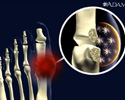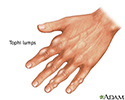Gout
Gouty arthritis - acute; Gout - acute; Hyperuricemia; Tophaceous gout; Tophi; Podagra; Gout - chronic; Chronic gout; Acute gout; Acute gouty arthritisGout is a type of arthritis. It occurs when uric acid builds up in the blood and causes inflammation in the joints.
Uric acid
Uric acid is a chemical created when the body breaks down substances called purines. Purines are normally produced in the body and are also found in...

Acute gout is a painful condition that often affects only one joint. Chronic gout is the repeated episodes of pain and inflammation. More than one joint may be affected.
Causes
Gout is caused by having higher-than-normal level of uric acid in your body. This may occur if:
- Your body makes too much uric acid
- Your body has a hard time getting rid of uric acid
When uric acid builds up in the fluid around the joints (synovial fluid), uric acid crystals form. These crystals cause the joint to become inflamed, causing pain, swelling and warmth.
The exact cause is unknown. Gout may run in families. The problem is more common in men, in women after menopause, and people who drink alcohol. As people become older, gout becomes more common.
The condition may also develop in people with:
-
Diabetes
Diabetes
Diabetes is a long-term (chronic) disease in which the body cannot regulate the amount of sugar in the blood.
 ImageRead Article Now Book Mark Article
ImageRead Article Now Book Mark Article - Kidney disease
-
Obesity
Obesity
Overweight and obesity mean having a weight than is higher than what is healthy for a given height. A person may be overweight from extra muscle, bo...
 ImageRead Article Now Book Mark Article
ImageRead Article Now Book Mark Article -
Sickle cell anemia and other anemias
Sickle cell anemia
Sickle cell disease is a disorder passed down through families. The red blood cells that are normally shaped like a disk take on a sickle or crescen...
 ImageRead Article Now Book Mark Article
ImageRead Article Now Book Mark ArticleAnemias
Anemia is a condition in which the body does not have enough healthy red blood cells. Red blood cells provide oxygen to body tissues. Normally, red ...
 ImageRead Article Now Book Mark Article
ImageRead Article Now Book Mark Article -
Leukemia and other blood cancers
Leukemia
Leukemia is a type of blood cancer that begins in the bone marrow. Bone marrow is the soft tissue in the center of the bones, where blood cells are ...
 ImageRead Article Now Book Mark Article
ImageRead Article Now Book Mark Article
Gout may occur after taking medicines that interfere with the removal of uric acid from the body. People who take certain medicines, such as hydrochlorothiazide and other water pills, may have a higher level of uric acid in the blood.
Symptoms
Symptoms of acute gout:
- In most cases, only one or a few joints are affected. The big toe, knee, or ankle joints are most often affected. Sometimes many joints become swollen and painful.
- The pain starts suddenly, often during the night. Pain is often severe, described as throbbing, crushing, or excruciating.
- The joint appears warm and red. It is most often very tender and swollen (it hurts to put a sheet or blanket over it).
- There may be a fever.
Fever
Fever is the temporary increase in the body's temperature in response to a disease or illness. A child has a fever when the temperature is at or abov...
 ImageRead Article Now Book Mark Article
ImageRead Article Now Book Mark Article - The attack may go away in a few days, but may return from time to time. Additional attacks often last longer.
The pain and swelling most often go away after the first attack. Many people will have another attack in the next 6 to 12 months.
Some people may develop chronic gout. This is also called gouty arthritis. This condition can lead to joint damage and loss of motion in the joints. People with chronic gout will have joint pain and other symptoms most of the time.
Deposits of uric acid can form lumps below the skin around joints or other places such as the elbows, fingertips, and ears. The lump is called a tophus, from Latin, meaning a type of stone. Tophi (multiple lumps) can develop after a person has had gout for many years. These lumps may drain chalky material.
Exams and Tests
Tests that may be done include:
-
Synovial fluid analysis (shows uric acid crystals)
Synovial fluid analysis
Synovial fluid analysis is a group of tests that examine joint (synovial) fluid. The tests help diagnose and treat joint-related problems.
 ImageRead Article Now Book Mark Article
ImageRead Article Now Book Mark Article -
Uric acid -- blood
Uric acid -- blood
Uric acid is a chemical created when the body breaks down substances called purines. Purines are normally produced in the body and are also found in...
 ImageRead Article Now Book Mark Article
ImageRead Article Now Book Mark Article -
Joint x-rays (may be normal)
Joint x-rays
This test is an x-ray of a knee, shoulder, hip, wrist, ankle, or other joint.
 ImageRead Article Now Book Mark Article
ImageRead Article Now Book Mark Article -
Synovial biopsy
Synovial biopsy
A synovial biopsy is the removal of a piece of tissue lining a joint for examination. The tissue is called the synovial membrane.
 ImageRead Article Now Book Mark Article
ImageRead Article Now Book Mark Article -
Uric acid -- urine
Uric acid -- urine
The uric acid urine test measures the level of uric acid in the urine. The uric acid blood level can be checked using a blood test.
 ImageRead Article Now Book Mark Article
ImageRead Article Now Book Mark Article
A uric acid level in the blood over 7.2 mg/dL (milligrams per deciliter) is high. But, not everyone with a high uric acid level has gout.
Treatment
Take medicines for gout as soon as you can if you have a new attack.
Take nonsteroidal anti-inflammatory drugs (NSAIDs) such as ibuprofen or indomethacin when symptoms begin. Talk to your health care provider about the correct dose. You may need stronger doses for a few days.
- A prescription medicine called colchicine helps reduce pain, swelling, and inflammation.
- Corticosteroids (such as prednisone) can also be very effective. Corticosteroids can be injected into the joint or taken as a pill. Your provider may inject the inflamed joint with steroids to relieve the pain.
- With attacks of gout in multiple joints an injectable medicine called anakinra (Kineret) may be used.
- The pain often goes away within 12 hours of starting treatment. Most of the time, all pain is gone within 48 hours.
You may need to take daily medicines such as allopurinol (Zyloprim), febuxostat (Uloric) or probenecid (Benemid) to decrease the uric acid level in your blood. Additionally, an intravenous medicine called pegloticase (Kystexxa) is available for severe cases. Lowering the uric acid to less than 6 mg/dL is needed to prevent deposits of uric acid. If you have visible tophi, the uric acid should be lower than 5 mg/dL.
You may need these medicines if:
- You have several attacks during the same year or your attacks are quite severe.
- You have damage to joints.
- You have tophi.
- You have kidney disease or kidney stones.
Kidney stones
A kidney stone is a solid mass made up of tiny crystals. One or more stones can be in the kidney or ureter at the same time.
 ImageRead Article Now Book Mark Article
ImageRead Article Now Book Mark Article
Diet and lifestyle changes may help prevent gouty attacks:
- Decrease alcohol, especially beer (some wine may be helpful).
- Lose weight.
- Exercise daily.
- Limit your intake of red meat and sugary beverages.
- Choose healthy foods, such as dairy products, vegetables, nuts, legumes, fruits (less sugary ones), and whole grains.
- Coffee and vitamin C supplements (may help some people).
Outlook (Prognosis)
Proper treatment of acute attacks and lowering uric acid to a level less than 6 mg/dL allows people to live a normal life. However, the acute form of the disease may progress to chronic gout if the high uric acid is not treated adequately.
Possible Complications
Complications may include:
- Chronic gouty arthritis.
- Kidney stones.
- Deposits in the kidneys, leading to chronic kidney failure.
Chronic kidney failure
Chronic kidney disease is the slow loss of kidney function over time. The main job of the kidneys is to remove wastes and excess water from the body...
 ImageRead Article Now Book Mark Article
ImageRead Article Now Book Mark Article
High levels of uric acid in the blood are associated with increased risk for kidney disease. Studies are being done to find out whether lowering uric acid reduces the risk for kidney disease.
When to Contact a Medical Professional
Contact your provider if you have symptoms of acute gouty arthritis or if you develop tophi.
Prevention
You may not be able to prevent gout, but you may be able to avoid things that trigger symptoms. Taking medicines to lower uric acid can prevent progression of gout. Over time, your deposits of uric acid will disappear.
References
Dalbeth N. Clinical features and treatment of gout. In: Firestein GS, Budd RC, Gabriel SE, Koretzky GA, McInnes IB, O'Dell JR, eds. Firestein & Kelley's Textbook of Rheumatology. 11th ed. Philadelphia, PA: Elsevier; 2021:chap 101.
Edwards NL. Crystal deposition diseases. In: Goldman L, Schafer AI, eds. Goldman-Cecil Medicine. 26th ed. Philadelphia, PA: Elsevier; 2020:chap 257.
FitzGerald JD, Dalbeth N, Mikuls T, et al. 2020 American College of Rheumatology Guideline for the management of gout. Arthritis Care Res (Hoboken). 2020;72(6):744-760. PMID: 32391934 pubmed.ncbi.nlm.nih.gov/32391934/.
FitzGerald JD, Neogi T, Choi HK. Editorial: do not let gout apathy lead to gouty arthropathy. Arthritis Rheumatol. 2017;69(3):479-482. PMID: 28002890 pubmed.ncbi.nlm.nih.gov/28002890/.
Liew JW, Gardner GC. Use of anakinra in hospitalized patients with crystal-associated arthritis. J Rheumatol. 2019;46(10)1345-1349. PMID: 30647192 pubmed.ncbi.nlm.nih.gov/30647192/.
-
Gout
Animation
-
Uric acid crystals - illustration
These spiked rods are uric acid crystals photographed under polarized light. Increased uric acid blood levels and formation of uric acid crystals in the joints are associated with gout.
Uric acid crystals
illustration
-
Tophi gout in hand - illustration
Chronic symptoms such as joint deformity and limitation of motion in affected joints may occur if several attacks of gout occur each year. Uric acid deposits called tophi develop in cartilage tissue, tendons, and soft tissues. These tophi usually develop only after a patient has suffered from the disease for many years. Deposits also can occur in the kidneys, leading to chronic renal failure.
Tophi gout in hand
illustration
-
Uric acid crystals - illustration
These spiked rods are uric acid crystals photographed under polarized light. Increased uric acid blood levels and formation of uric acid crystals in the joints are associated with gout.
Uric acid crystals
illustration
-
Tophi gout in hand - illustration
Chronic symptoms such as joint deformity and limitation of motion in affected joints may occur if several attacks of gout occur each year. Uric acid deposits called tophi develop in cartilage tissue, tendons, and soft tissues. These tophi usually develop only after a patient has suffered from the disease for many years. Deposits also can occur in the kidneys, leading to chronic renal failure.
Tophi gout in hand
illustration
-
Gout
(Alt. Medicine)
-
Gout - InDepth
(In-Depth)
-
Gout medications - uricosuric agents
(Alt. Medicine)
Review Date: 4/30/2023
Reviewed By: Neil J. Gonter, MD, Assistant Professor of Medicine, Columbia University, New York, NY, and private practice specializing in Rheumatology at Rheumatology Associates of North Jersey, Teaneck, NJ. Review provided by VeriMed Healthcare Network. Also reviewed by David C. Dugdale, MD, Medical Director, Brenda Conaway, Editorial Director, and the A.D.A.M. Editorial team.





